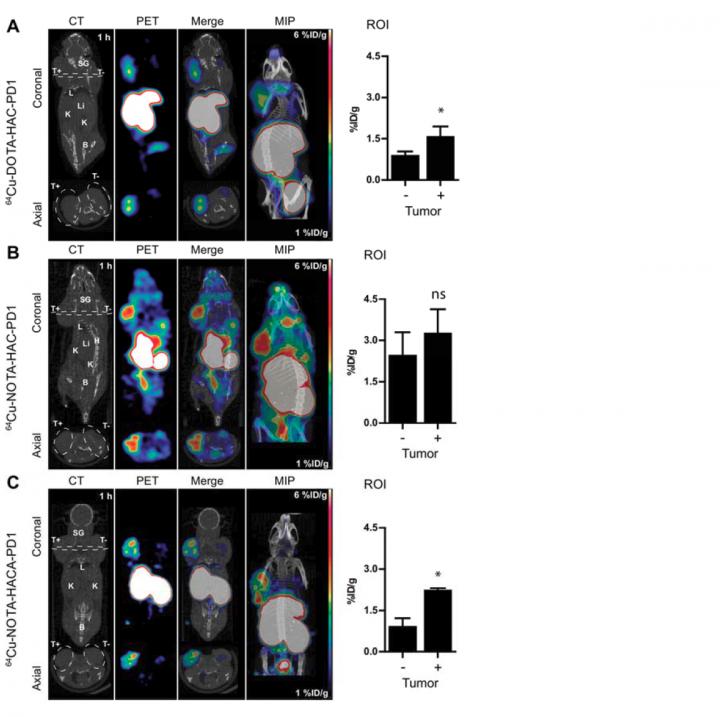
Credit: Sam Gambhir, MD, PhD, Stanford University
In an article published in the April issue of "The Journal of Nuclear Medicine," researchers at Stanford University in California provide a template for assessing new positron emission tomography (PET) radiotracers that can accurately identify molecules in cancer cells that prevent the immune system from attacking the cancer.
A drug that blocks a cancer's inhibitory checkpoint molecules is called an immune checkpoint inhibitor and this form of immunotherapy has emerged as a promising cancer treatment approach. However, the lack of imaging tools to assess immune checkpoint expression has been a major barrier to predicting and monitoring response to a clinical checkpoint blockade.
"Because immunotherapies for cancer are expanding, methods to optimize them for an individual patient through molecular imaging are needed," explains Sam Gambhir, MD, PhD, at Stanford University. "Using animal models, this study shows the development of several new engineered PET tracers that can help image the immune system in action and be used to monitor checkpoint inhibitor therapy."
The study assessed practical immunoPET radiotracer design modifications and their effects on human PD-L1 immune checkpoint imaging. The researchers sought to optimize engineering design parameters including chelate, glycosylation, and radiometal to develop a non-invasive molecular imaging tool for eventual monitoring of clinical checkpoint blockade.
Gambhir points out, "This research will ultimately allow for translation to human imaging of the tracer that worked best in animal models. An effective immunoPET tracer will help patients receiving checkpoint inhibitor immunotherapy get optimal treatment and have the best chance for fighting their cancer."
Molecular imaging is playing an increasingly integral role in immunotherapy and personalized medicine. Looking ahead, Gambhir envisions "a lot more use of PET/CT or PET/MR imaging for patients undergoing immunotherapy." He adds, "This and related research will also help us develop other imaging approaches for understanding the immune system in action."
###
The authors of "Practical ImmunoPET radiotracer design considerations for human immune checkpoint imaging" include Aaron T. Mayer, Arutselvan Natarajan, Sydney R. Gordon, Roy L. Maute, Melissa N. McCracken, Aaron M. Ring, Irving L. Weissman and Sanjiv S. Gambhir, Stanford University, Stanford, California.
Support for this study was provided by Kenneth Lau, Frezghi Habte, the Canary Foundation and the Ben and Catherine Ivy Foundation. This material is based upon work supported by a National Science Foundation Graduate Research Fellowship Grant (DGE-114747) and a NIH TBi2 Training Grant (2T32EB009653-06). MicroPET/CT imaging and Gamma Counter measurements were performed in the SCi3 Stanford Small Animal Imaging Service Center.
Please visit the SNMMI Media Center to view the PDF of the study, including images, and more information about molecular imaging and personalized medicine. To schedule an interview with the researchers, please contact Laurie Callahan at (703) 652-6773 or [email protected]. Current and past issues of The Journal of Nuclear Medicine can be found online at http://jnm.snmjournals.org.
About the Society of Nuclear Medicine and Molecular Imaging
The Society of Nuclear Medicine and Molecular Imaging (SNMMI) is an international scientific and medical organization dedicated to raising public awareness about nuclear medicine and molecular imaging, a vital element of today's medical practice that adds an additional dimension to diagnosis, changing the way common and devastating diseases are understood and treated and helping provide patients with the best health care possible.
SNMMI's more than 17,000 members set the standard for molecular imaging and nuclear medicine practice by creating guidelines, sharing information through journals and meetings and leading advocacy on key issues that affect molecular imaging and therapy research and practice. For more information, visit http://www.snmmi.org.
Media Contact
Laurie Callahan
[email protected]
@SNM_MI
http://www.snm.org
############
Story Source: Materials provided by Scienmag





